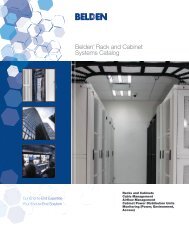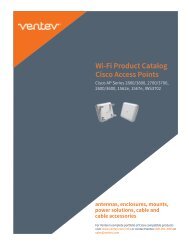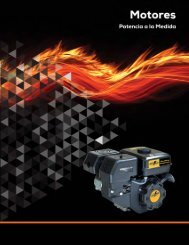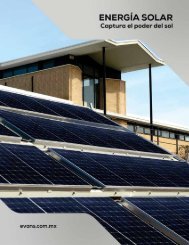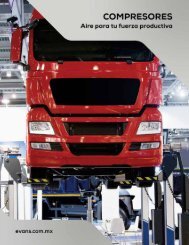Unleashing Stranded Power and Reducing Costs
You also want an ePaper? Increase the reach of your titles
YUMPU automatically turns print PDFs into web optimized ePapers that Google loves.
<strong>Unleashing</strong> <strong>Str<strong>and</strong>ed</strong> <strong>Power</strong> <strong>and</strong> <strong>Reducing</strong> <strong>Costs</strong><br />
Using Shared Zero-U Space with Siemon VersaPOD ® Cabinets<br />
In modern data centers, servers account for the majority of equipment <strong>and</strong> perform most of the processing work.<br />
It therefore comes as no surprise that servers also present most of the power <strong>and</strong> thermal challenges <strong>and</strong> take up the<br />
most cabinet space in the data center.<br />
Many data center managers prefer to use narrow 600mm (24 in.) server cabinets, assuming they can maximize space<br />
by accommodating more cabinets within the square footage of the data center. Not only is this a misconception, but<br />
deploying wider cabinets such as Siemon VersaPOD cabinets that share Zero-U space between bayed cabinets is<br />
proven to reduce str<strong>and</strong>ed power <strong>and</strong> provide substantial cost savings without sacrificing space.<br />
www.siemon.com 1
Zero-U Space with VersaPOD ®<br />
The Smaller Cabinet Misconception<br />
When we consider the data center as a whole, it is important to underst<strong>and</strong> that the total power of the space is allocated<br />
across all cabinets housing active equipment. Accordingly, regardless of whether a data center contains a greater<br />
number of smaller cabinets or fewer larger cabinets, the overall power load remains the same. As shown in Figure 1,<br />
whether a 50kW data center row houses 10 narrow 5kW cabinets or 8 wider 6.25kW cabinets, the total allocated power<br />
remains at 50kW per row. The same holds true for colocation facilities where power is generally allocated based on<br />
customer cages—total power of the cage is allocated across the cabinets housed within that cage.<br />
Figure 1: 10 narrow 5kW cabinets <strong>and</strong> 8 wider 6.25kW cabinets equal the same overall power allocation occupying<br />
approximately the same footprint.<br />
The number of servers that can reside in a cabinet is limited based on power, weight <strong>and</strong> space. The international<br />
average amount of power supplied to a server cabinet ranges between 5.5 <strong>and</strong> 6kW with many colocation data centers<br />
setting a limit of 5kW per narrow 600mm (24 in.) cabinet. This means that on average a typical server cabinet can<br />
hold about 12 to 15 servers respectively. Using fewer wider cabinets such as the Siemon VersaPOD® cabinet, the<br />
power supplied to each cabinet can be increased, allowing the wider cabinet to support more servers. Using our above<br />
example for the 50kW row, the smaller 5kW cabinet can support 12 servers, while a larger 6.25kW cabinet can<br />
support 15. Simply put, wider cabinets do not mean less servers—they mean more servers placed vertically in fewer<br />
cabinets. With chimneys or containment systems <strong>and</strong> higher power, even greater vertical growth <strong>and</strong> cabinet<br />
utilization is achievable. Based on these factors, the belief that having a greater number of smaller footprint cabinets<br />
will maximize space is a misconception.<br />
Furthermore, vertical growth is rapidly becoming a trend. In the past, data center <strong>and</strong> facilities managers believed that<br />
exp<strong>and</strong>ing the amount of floor space in the data center was the key to supporting future IT requirements. Now the idea<br />
of basing growth on floor space is going by the wayside as data centers strive to support higher power loads <strong>and</strong><br />
optimize cabinet use through vertical growth.<br />
In contrast to growing horizontally by adding additional cabinets in the space, growing vertically by placing more servers<br />
in fewer wider cabinets maximizes existing space while providing enhanced cable management within the cabinet.<br />
This is especially beneficial for data centers that simply do not have any more floor space available. In fact, many<br />
colocation environments are rewarding tenants for growing vertically where they have the power available to do so.<br />
It’s easy to see why this makes sense from a colocation owner point of view—having tenants grow vertically within the<br />
confines of their leased space leaves more floor space available to accommodate additional tenants.<br />
2 www.siemon.com
Delivering <strong>Power</strong> to the Cabinet<br />
<strong>Power</strong> distribution units (PDUs) distribute power to active equipment. Sized based on<br />
the amount of power allocated to the cabinet, they are horizontally or vertically<br />
mounted in each cabinet <strong>and</strong> come in a variety of types, including st<strong>and</strong>ard, intelligent,<br />
monitored, switched <strong>and</strong> managed. They also come in a wide range of customizable<br />
configurations <strong>and</strong> number of receptacles.<br />
For every PDU in a cabinet, there is also a connection to main power that includes an<br />
input power whip <strong>and</strong> a breaker or power bus connection in the main power panels.<br />
Excluding the actual cost of the PDU itself, some consultants place the cost to<br />
connect power to a PDU at roughly $565 for the whip, breaker <strong>and</strong> labor (note: power<br />
connection prices <strong>and</strong> labor rates may vary by location). Since most cabinets have two<br />
PDUs—one for primary power <strong>and</strong> one for secondary power—the cost to run power<br />
to PDUs in 200 cabinets would be approximately $226,000 (200 X $565 X 2). Cutting<br />
down on the number of cabinets <strong>and</strong> PDUs by deploying wider higher density cabinets<br />
saves on the expense of power runs. Since some power is lost in distribution from<br />
one point to another, fewer power runs also means overall less power loss. This helps<br />
improve <strong>Power</strong> Usage Effectiveness (PUE), which is used to measure data center<br />
efficiency <strong>and</strong> is calculated by the power input to a facility divided by the actual power<br />
used by the IT equipment.<br />
The <strong>Str<strong>and</strong>ed</strong> <strong>Power</strong> Conundrum<br />
Zero-U Space with VersaPOD ®<br />
Once an amount of power is assigned to a cabinet, it cannot be used elsewhere. The power that is allocated to the cabinet<br />
stays allocated whether all of the power receptacles on the PDU consume the power or not. Whenever the power<br />
distributed to a cabinet exceeds the power actually consumed by the equipment the result is defined as str<strong>and</strong>ed power.<br />
While having just a few unused receptacles per cabinet may seem minor, when multiplied across hundreds of cabinets, the<br />
amount of str<strong>and</strong>ed power can reach a significant percentage of the total power available in the data center.<br />
Not only does str<strong>and</strong>ed power occur due to power being provisioned to a single cabinet that cannot be assigned elsewhere,<br />
it is also caused by servers being provisioned at higher than used ratings. Let’s consider a data center cabinet where<br />
24-outlet PDUs are used to power 12 servers that are expected to draw a maximum of 5.4kW total power based on each<br />
server’s 450W nameplate rating. However, servers rarely ever reach their nameplate rating—experts estimate maximum<br />
power to be 65 to 70% of the nameplate rating. Whenever the servers consume less power than what is allocated to the<br />
cabinet, the result is str<strong>and</strong>ed power (see Figure 2). For example, an actual load of 200W per server would result in a total<br />
of 3kW of str<strong>and</strong>ed power (450W-200W X 12 = 3kW).<br />
While data center designers have gotten better at provisioning based on estimates of actual power consumption rather than<br />
nameplate ratings, power remains a dominant contributor to capital expenditures (CapEX) <strong>and</strong> a significant<br />
contributor to operating expenses (OpEX). With power estimated at 50% of the total cost of ownership, today’s data<br />
centers continue to look for ways to optimize power use.<br />
Figure 2: Whenever servers consume less than the<br />
allocated power, the result is str<strong>and</strong>ed power.<br />
www.siemon.com<br />
3
Zero-U Space with VersaPOD ®<br />
Solution: VersaPOD ® with Shared Zero-U Space<br />
A unique way to solve the problem of str<strong>and</strong>ed power in the data center is to deploy wider Siemon VersaPOD cabinets<br />
designed with recessed corner posts/mounting rails that create a vertical Zero-U space between bayed cabinets <strong>and</strong><br />
at the end of row. The Zero-U space is nearly 178mm (7 in.) wide <strong>and</strong> provides 150mm (6 in.) of clearance between<br />
equipment mounting rails <strong>and</strong> doors at the front <strong>and</strong> rear. This vertical Zero-U space at the front <strong>and</strong> rear between<br />
bayed cabinets can be used for patching, cable management <strong>and</strong> power distribution. Not only does the VersaPOD<br />
Zero-U space free up horizontal equipment mounting space, it also allows PDUs to be shared between two cabinets.<br />
This increases the number of used power ports <strong>and</strong> reduces str<strong>and</strong>ed power (see Figure 3).<br />
Locating PDUs in the shared Zero-U space means that PDUs only<br />
need to be installed in the Zero-U space between every other cabinet.<br />
This cuts the required number of PDUs <strong>and</strong> upstream power<br />
connections (whips, breakers <strong>and</strong> installation) in half. For example,<br />
a data center with 200 VersaPOD cabinets would only require<br />
100 PDUs for primary power <strong>and</strong> 100 for secondary power versus<br />
a data center with 200 self-contained cabinets that would require<br />
200 PDUs for primary power <strong>and</strong> 200 for secondary. At $565 per<br />
upstream power connection, using VersaPOD cabinets in this scenario<br />
saves $113,000 on power runs alone.<br />
Not only does sharing PDUs via Zero-U space offer significant<br />
savings on PDUs <strong>and</strong> power connections, it also helps reduce<br />
str<strong>and</strong>ed power. For example, a self-contained cabinet with 12<br />
servers would use 12 of the 24 outlets on each PDU <strong>and</strong> essentially<br />
ab<strong>and</strong>on the remaining. In contrast, two VersaPOD cabinets<br />
with 15 servers that share two 30-outlet PDUs mounted in the<br />
Zero-U space would use all of the outlets. It’s important to note<br />
that while 24 outlets is a common configuration for PDUs, higher<br />
receptacle port counts can be used to further maximize savings.<br />
The cost of a 30-outlet shared PDU in the VersaPOD is only<br />
slightly higher cost than a 24-outlet PDU, <strong>and</strong> it increases the usable<br />
vertical server space via higher power per PDU <strong>and</strong> additional<br />
usable outlets across the two cabinets.<br />
Figure 3: VersaPOD Zero-U space with primary <strong>and</strong> secondary<br />
PDUs shared between two cabinets<br />
The shared Zero-U space between bayed VersaPOD cabinets offers additional savings as well. Copper <strong>and</strong> fiber<br />
connections are located in the Zero-U space <strong>and</strong> therefore like the PDUs, they only need to be installed every other<br />
cabinet. Depending on the number of cabinets in a row, end of row patch panels or PDUs are available to round out<br />
the row (see Figure 4). In addition, because the shared patch panels are located in the Zero-U space directly to the side<br />
of the servers, shorter 1-meter copper patch cords <strong>and</strong> fiber jumpers can be used to make the connections <strong>and</strong><br />
horizontal cable managers are replaced by vertical cable management fingers. With typical self-contained cabinets,<br />
patch panels are installed at the top of every cabinet, requiring longer 2 <strong>and</strong> 3-meter cords <strong>and</strong> jumpers to connect to<br />
all of the servers. Maintaining inventory of multiple longer cords <strong>and</strong> jumpers costs about 40% more, <strong>and</strong> can cost even<br />
more in data centers that use color coding.<br />
4 www.siemon.com
Figure 4: VersaPOD cabinets with shared Zero-U space between bayed cabinets allows PDUs <strong>and</strong> patch panels to be<br />
installed in every other cabinet, while enabling better PDU utilization <strong>and</strong> shorter patch cords <strong>and</strong> jumpers.<br />
It’s important to note that at a width of 762mm (30 in.) the VersaPOD cabinet is wider than the smaller 600 mm (24 in.)<br />
cabinets that some data center professionals believe will maximize space. However, as previously discussed,<br />
deploying fewer wider VersaPOD cabinets cuts down on the number of cabinets <strong>and</strong> increases the power load per<br />
cabinet, enabling vertical growth within a similar footprint <strong>and</strong> maintaining the same power load across the data<br />
center. Data centers should therefore not assume that floor space originally planned for smaller width cabinets will not<br />
accommodate wider VersaPOD cabinets. At 762mm (30 in), VersaPOD cabinets can also save space over wider<br />
(i.e. 800mm) self-contained cabinets. While some 800mm cabinets feature Zero-U space for vertical patching <strong>and</strong><br />
power distribution, self-contained cabinets do not have the ability to easily share this space between two bayed<br />
cabinets like the VersaPOD. Siemon Design Services can help determine how many VersaPODs will fit into a specific<br />
space, provide analysis on the potential cost savings of shared Zero-U space, <strong>and</strong> adjust power <strong>and</strong> cabling plans<br />
accordingly.<br />
Zero-U Space with VersaPOD ®<br />
Cost Analysis of Using VersaPOD vs. Self-Contained Server Cabinets<br />
To further illustrate the decrease in str<strong>and</strong>ed power <strong>and</strong> cost savings of using VersaPOD cabinets with shared Zero-U<br />
space versus narrower self-contained cabinets, Siemon has conducted a cost analysis based on a 20-pod data center<br />
(see sidebar). Depending on the cabinet width, each pod contains 20 or 16 cabinets <strong>and</strong> fits within about 6.4 linear<br />
meters (21 linear feet). This analysis compares the following pod configurations (see Figure 5):<br />
• Two rows of 8 wider 762mm (30 in.) VersaPOD cabinets with shared Zero-U space totaling<br />
6.1m (19 ft. 8 in.) of linear feet<br />
• Two rows of 10 narrow 600mm (24 in.) server cabinets without shared Zero-U space totaling<br />
6m (20 ft.) of linear feet<br />
• Two rows of 8 wider 800mm (31.5 in.) server cabinets without shared Zero-U space totaling<br />
6.4m (20 ft. 11 in.) of linear feet<br />
The VersaPOD <strong>and</strong> the 800mm (31.5 in.) cabinets contain 15 servers per cabinet at 6.25kW per cabinet, while the<br />
600mm (24 in.) cabinets are utilizing 5kW per cabinet <strong>and</strong> therefore can only support 12 servers per cabinet.<br />
The VersaPOD shares two 30-outlet PDUs between every two cabinets, while the 600mm cabinets <strong>and</strong> 800mm<br />
cabinets use two 24-outlet PDUs per self-contained cabinet for primary <strong>and</strong> secondary power.<br />
The analysis assumes two copper connections per server for primary <strong>and</strong> secondary networking, two fiber connections<br />
per server for primary <strong>and</strong> secondary SAN, <strong>and</strong> two power connections per server for primary <strong>and</strong> secondary power.<br />
The analysis takes into consideration the fact that PDUs <strong>and</strong> patching can be shared between two VersaPOD cabinets<br />
using the shared Zero-U space with two PDUs at the ends of the rows.<br />
www.siemon.com<br />
5
Zero-U Space with VersaPOD ®<br />
Figure 5: Comparison of Cabinet Rows with VersaPOD 762mm (30 in.) with Shared Zero-U Space vs. 600mm (24 in.)<br />
<strong>and</strong> 800mm (31.5 in.) Self-Contained Cabinets<br />
6 www.siemon.com
Price for the cost comparison is based on MSRP. The<br />
price for copper <strong>and</strong> fiber patching with the VersaPOD is<br />
based on Siemon’s Vertical Patch Panels that mounts<br />
within the Zero-U space. With support for up to 96 copper<br />
ports <strong>and</strong> up to 288 duplex fiber connections per upper<br />
<strong>and</strong> lower section, the Vertical Patch Panel provides<br />
plenty of copper <strong>and</strong> fiber patching connections to<br />
support both adjacent VersaPOD cabinet connectivity<br />
requirements (See Figure 6).<br />
Figure 6: Siemon Vertical Patch Panels that reside<br />
in the Zero-U space between VersaPOD cabinets<br />
can support up to 96 copper ports <strong>and</strong> 288 duplex<br />
fiber ports per upper <strong>and</strong> lower section.<br />
Pod-based Data Centers<br />
Within a data center, pods are groups of cabinets that may<br />
be based on capacity, application or scalability. They are<br />
essentially compartmentalized areas of the data center, <strong>and</strong><br />
sometimes referred to as data center halls or cells.<br />
Pods often consist of two symmetrical rows of cabinets that<br />
are compatible with aisle containment systems (i.e., hot<br />
aisle or cold aisle containment). A data center may contain<br />
any number of pods, <strong>and</strong> they are typically repeated as the<br />
data center grows. This allows customers to scale the data<br />
center in a very predictable manner. Replicating cabinets<br />
<strong>and</strong> components from pod to pod during expansions provides<br />
predictable power, cooling <strong>and</strong> space consumption.<br />
Additional pods can be added with ease <strong>and</strong> confidence,<br />
rather than risky traditional design methods where growth is<br />
addressed on an as-needed basis <strong>and</strong> cabinets <strong>and</strong> components<br />
are piecemealed together based on an ad hoc design.<br />
With each pod using identical cabinets <strong>and</strong><br />
components, there is also a common look to the data center<br />
with an organized floor layout that improves overall aesthetics.<br />
Zero-U Space with VersaPOD ®<br />
To further support pod-based data center designs, Siemon<br />
V-Built Preconfigured Data Center Cabinets are custom<br />
kitted with preloaded Siemon components, including PDUs,<br />
fiber enclosures <strong>and</strong> copper patch panels, pre-terminated<br />
trunking cables, patch cords <strong>and</strong> jumpers, cable management<br />
<strong>and</strong> accessories. Assembled <strong>and</strong> packaged at one of<br />
Siemon’s regional manufacturing facilities, V-Built cabinets<br />
arrive at the customer site ready to install the active equipment<br />
<strong>and</strong> finalize the connections. Each V-Built cabinet with<br />
its preloaded components is identified by a unique customer-specific<br />
part number for easy ordering of future identical<br />
cabinets.<br />
www.siemon.com<br />
7
Zero-U Space with VersaPOD ®<br />
As shown in Table 1, for a data center with 20 pods, the use of VersaPOD cabinets with shared Zero-U space saves<br />
a compelling 40% compared to 800mm <strong>and</strong> about 46% compared to 600mm self-contained cabinets. Even more<br />
compelling is the savings on str<strong>and</strong>ed power connections. With VersaPOD cabinets sharing two 30-outlet PDUs<br />
shared between two bayed cabinets, they require half the number of PDUs of the 600mm <strong>and</strong> 800mm self-contained<br />
cabinets that both use two 24-outlet PDUs per cabinet. The result is only 120 unused PDU outlets per pod for the VersaPOD<br />
at the ends of each row, which can be used for future expansion if needed. In contrast, the 600mm cabinets<br />
results in 480 unused outlets <strong>and</strong> the 800mm cabinets results in 288 unused outlets. What is not shown in this cost<br />
analysis are the additional savings on the whip, breaker <strong>and</strong> labor for the upstream power runs. With half the<br />
number of PDUs for VersaPOD cabinets compared to 600mm cabinets, VersaPOD can save up to 50% or more on<br />
power runs. Taking all of these savings into consideration, it is clear that VersaPOD cabinets can cut data centers<br />
costs substantially for both CapEX <strong>and</strong> OpEX. In addition, having fewer power connections with VersaPOD cabinets<br />
results in reduced power loss <strong>and</strong> an increase in PUE.<br />
Components Per Pod VersaPOD 762 600 Wide 800 Wide<br />
# Cabs Arranged in a Two-row Pod 16 20 16<br />
Linear Dimension of Row 6.1 m (20 ft.) 6 m (19 ft. 8 in.) 6.4 m (20 ft. 11 in.)<br />
# Available RU 1088 900 720<br />
# Servers / Cab (240 servers per Pod) 15 12 15<br />
Combo Vertical Copper/Fiber Panel 8 N/A N/A<br />
# Patch Panels 0 20 16<br />
# Fiber Panels 0 20 16<br />
# Horizontal Wire Managers 0 40 32<br />
# PDUs 20 40 32<br />
Total PDU outlets 600 1 960 768<br />
<strong>Str<strong>and</strong>ed</strong> PDU ports 120 480 288<br />
PDU Brackets 10 2 40 32<br />
1m Patch Cords/Jumpers 3 960 0 0<br />
2m Patch Cords/Jumpers3 0 480 480<br />
3m Patch Cords/Jumpers3 0 480 480<br />
Total Cost per Pod $ 162,028 $ 300,722 $ 269,644<br />
Cost per RU per Pod $149 $334 $318<br />
Cost per Server $ 675 $ 1,253 $ 1,124<br />
Total Cost per All 20 Pods $ 3,240,560 $ 6,014,440 $ 5,392,860<br />
Table 1: Cost comparison for a 20-Pod Data Center Using VersaPOD with Shared Zero-U Space vs. 600mm <strong>and</strong> 800mm Self-<br />
Contained Cabinets<br />
1. Assumes two 30-outlet PDUs between two VersaPODs <strong>and</strong> at ends of rows <strong>and</strong> two 24-outlet PDUs for each 600mm <strong>and</strong> 800mm cabinet.<br />
2. One PDU bracket can support two PDUs in the VersaPOD, while the self-contained cabinets require a bracket on both sides.<br />
3. Assumes 30 patch cords <strong>and</strong> 30 jumpers (2 each per server) for VersaPOD <strong>and</strong> 800mm cabinets <strong>and</strong> 24 patch cords <strong>and</strong> 24 jumpers<br />
(2 each per server) for 600mm cabinets.<br />
8 www.siemon.com
Conclusion<br />
Often data center managers prefer less-expensive,<br />
smaller-width server cabinets, believing that they offer<br />
more useable space. Regardless, the amount of power<br />
load in the data center is divided by the number of cabinets.<br />
With fewer, wider cabinets such as Siemon’s VersaPOD<br />
within the same space, the power per cabinet<br />
can be increased to support more servers per cabinet,<br />
enabling cost-effective vertical growth. It is therefore a<br />
misconception that smaller cabinets offer more usable<br />
space.<br />
Rather than comparing cabinet to cabinet prices, it is<br />
crucial to look at the cabinets as a total solution.<br />
The ability of Siemon VersaPOD cabinets to share connectivity,<br />
patching <strong>and</strong> PDUs in the Zero-U space<br />
between bayed cabinets significantly reduces the<br />
number of PDUs, upstream power connections <strong>and</strong><br />
str<strong>and</strong>ed power. When comparing VersaPOD to<br />
600mm cabinets as illustrated in Table 1, 46% savings<br />
can be realized due to the reduced number of cabinets,<br />
PDUs, mounting brackets <strong>and</strong> patch panels, as well as<br />
the ability to use shorter patch cords. Roughly a 40%<br />
savings can be realized using shorter 1m copper <strong>and</strong><br />
fiber jumpers due to the vertical Zero-U patching orientation<br />
alone. In addition, str<strong>and</strong>ed power outlets are<br />
reduced by 75%. All of these savings combined result<br />
in tremendous CapEX <strong>and</strong> OpEX savings.<br />
Zero-U Space with VersaPOD ®<br />
Siemon Design Services can assist you with your data center design <strong>and</strong> perform a detailed custom cost analysis to<br />
determine how much you can save using VersaPOD cabinets. Siemon Design Services can provide 2D <strong>and</strong> 3D<br />
layouts, bills of material, thermal analysis <strong>and</strong> custom-configured <strong>and</strong> kitted V-Built cabinet part numbers.<br />
For more information on Siemon cabinets <strong>and</strong> design services, please visit<br />
www.siemon.com or contact your local sales representative.<br />
www.siemon.com<br />
9
Zero-U Space with VersaPOD ®<br />
10 www.siemon.com
Zero-U Space with VersaPOD ®<br />
www.siemon.com<br />
11
Zero-U Space with VersaPOD ®<br />
Worldwide Headquarters<br />
North America<br />
Watertown, CT USA<br />
Phone (1) 860 945 4200 US<br />
Phone (1) 888 425 6165<br />
Regional Headquarters<br />
EMEA<br />
Europe/Middle East/Africa<br />
Surrey, Engl<strong>and</strong><br />
Phone (44 ) 0 1932 571771<br />
Regional Headquarters<br />
Asia/Pacific<br />
Shanghai, P.R. China<br />
Phone (86) 21 5385 0303<br />
Regional Headquarters<br />
Latin America<br />
Bogota, Colombia<br />
Phone (571) 657 1950/51/52<br />
WP_ZeroU_ Rev.A 7/15<br />
www.siemon.com




